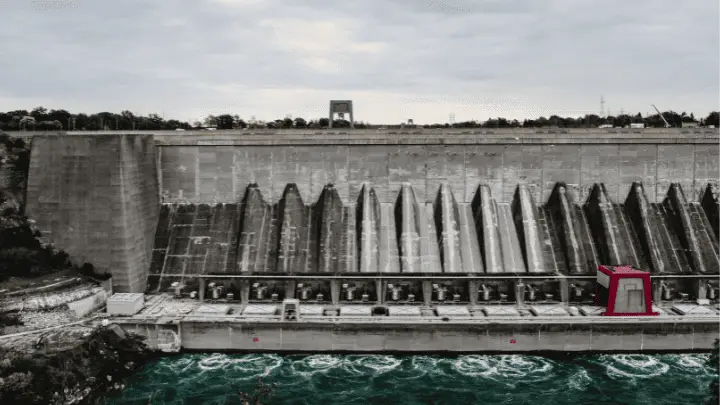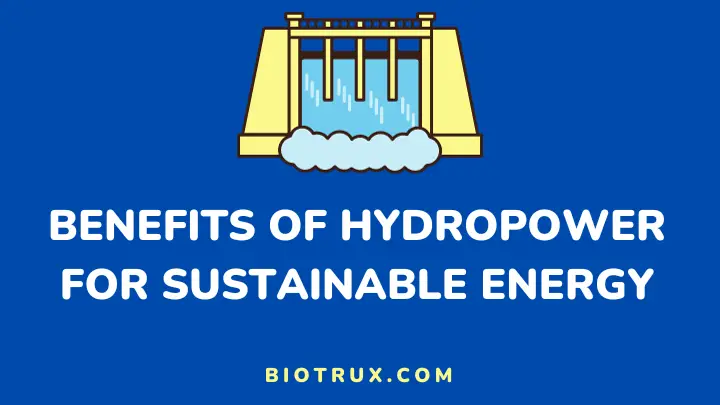Hydropower has long been recognized as one of the most reliable and sustainable energy sources with many benefits. It is renewable, abundant, and produces no emissions or hazardous waste.
Not only is hydropower a clean source of energy, but it is also cost-effective and provides a steady supply of electricity. It can be used to power homes, businesses, and entire communities, making it a vital part of the future of energy production.
In this article, I will discuss the many benefits of hydropower, and how it can help us create a more sustainable future. You will learn more about how it can help reduce emissions, create jobs, and provide clean energy for everyone.
Overview of Hydropower as a Sustainable Energy Source
Hydropower, commonly called hydroelectric power, is a renewable energy source that generates electricity by harnessing the energy of flowing water. The damming of a river or the diversion of water into a channel to create a reservoir is the first step in the process.
Water goes through turbines as it is released from the reservoir and flows downstream. These turbines are linked to generators, which turn the water’s kinetic energy into electrical energy.
The amount of power generated is determined by the flow rate of the water and the height from which it falls (head). When effectively managed, hydropower has a long operational lifespan and has little environmental impact.
It is an important part of the clean energy landscape, propelling us toward a more sustainable and environmentally friendly future. Hydropower is a cornerstone of renewable energy and substantially contributes to lowering greenhouse gas emissions.
This is because it is dependable, environmentally friendly, and versatile. Hydropower has numerous benefits that have a significant impact on sustainable energy production.
1. Renewable and Clean Energy
The power of flowing water can be used to create electricity through hydropower, a renewable energy source. It is a renewable energy source that relies on the Earth’s water cycle, making it an environmentally favorable option.
Hydropower plants emit no hazardous pollutants, giving them a more environmentally friendly alternative to fossil fuels. Furthermore, hydropower can store energy, ensuring a consistent electricity supply even during peak demand periods.
Overall, hydropower is a dependable and environmentally friendly energy source that can supply our energy demands while lowering our carbon footprint.
2. Abundant and Reliable
Hydropower is a plentiful and dependable source of renewable energy. One of the primary reasons hydropower is an appealing alternative for energy generation is the availability of water resources.
Natural water sources such as rivers, streams, and lakes can be exploited to generate electricity via hydropower. Hydropower plants are also reliable energy sources, providing constant electricity generation, unlike other renewable sources like wind and solar, which rely on weather conditions.
Furthermore, hydropower is a dependable energy source that reduces our dependence on fossil fuels. As the globe moves toward greener energy sources, hydropower will continue to play an important role.
Because of its abundance, dependability, and ability to lessen reliance on fossil fuels, it is an excellent answer for meeting our energy demands while safeguarding the environment.
3. Water Resource Management
Hydropower is a great renewable energy source with several benefits, including water resource management. One of the primary benefits of hydropower is that it aids in regulating water flow in rivers and streams.
Depending on the need for irrigation, electricity, and flood control, hydropower facilities can store and release water as needed. This water supply regulation is critical for agricultural operations because it assures a steady flow of water to crops, which leads to greater yields.
Furthermore, hydropower facilities can help reduce flood danger by releasing water during dry seasons or periods of low demand. As a result, hydropower is not only an outstanding renewable energy source but also a vital instrument for water resource management.
4. Flood Control
Many hydropower projects not only generate electricity but also serve as flood control mechanisms. They are designed to reduce the risk of flooding in the surrounding areas, protecting communities from the devastating effects of floods.
Hydropower dams regulate water flow in a river or stream, preventing sudden and extreme changes in water levels downstream. This helps to prevent floods and the damage they can cause to homes, businesses, and infrastructure.
Moreover, the reservoirs created by hydropower dams can store excess water during periods of heavy rainfall. When water levels rise, the dam holds back the excess water, and the stored water can be released to help maintain a steady flow downstream.
In addition to flood control, hydropower dams can improve water quality downstream. By regulating the flow of water, they can help to reduce erosion and sedimentation, which can lead to a cleaner and healthier aquatic environment.
5. Job Creation
The construction and maintenance of hydropower plants create numerous job opportunities, providing a significant boost to the local economies.
The construction phase of these plants requires skilled laborers, engineers, and technicians, along with heavy machinery operators and administrative staff. Additionally, the operation and maintenance of these plants require qualified professionals like plant managers, mechanics, and electricians.
The creation of these job opportunities helps to support the local communities while promoting sustainable energy production.
6. Recreational Opportunities
Hydropower reservoirs often become recreational areas, offering activities like boating, fishing, and hiking. These reservoirs can serve as a hub of outdoor activities for local communities.
It provides an opportunity for people to engage in outdoor activities while enjoying the natural beauty of the region. The reservoirs created by hydropower dams can also be used for swimming, kayaking, and other water sports activities.
The recreational opportunities offered by hydropower reservoirs not only promote healthy lifestyles but also contribute to the local economy by attracting tourists and generating revenue for surrounding businesses.
7. Low Operating Costs
Hydropower is a sustainable and reliable energy source that offers numerous benefits. First and foremost, its initial investment may appear higher compared to other energy sources, but it’s essential to understand the bigger picture.
The true beauty of hydropower lies in its low operating and maintenance costs, which translate into significant long-term savings. Hydropower plants are designed to endure, often exceeding 50 years of reliable service. This longevity translates to lower operational expenses and increased revenue generation.
Hydropower stands as a cost-effective, sustainable, and forward-thinking energy source that not only offers environmental benefits but also long-term economic advantages. Its low operating and maintenance costs make it the ultimate solution for meeting energy demands while reducing carbon emissions.
8. Flexibility
Hydropower stands out as a sustainable energy source, offering many benefits. One of its most notable benefits lies in its exceptional flexibility.
In contrast to other renewable energy sources like solar and wind, hydropower possesses the unique ability to adapt to meet the fluctuating demands for electricity. Hydropower plants can be seamlessly adjusted, whether to ramp up or down, ensuring a reliable and responsive energy supply.
This adaptability of hydropower not only guarantees a stable grid but plays a vital role in facilitating the seamless integration of other renewable energy sources. In essence, the flexibility of hydropower is pivotal in steering us toward a sustainable energy future.
9. Hydropower Can Help Reclaim Marshy Areas
Hydropower offers a multitude of advantages, with one of the most remarkable being its ability to transform marshy landscapes. This transformation is achieved through the construction of dams, giving rise to expansive reservoirs that serve as invaluable water storage.
This stored water can be strategically released to nurture farmlands and quench the thirst of local communities. Furthermore, these dams act as guardians of water flow, effectively preventing catastrophic floods in vulnerable low-lying regions.
As a result, they facilitate the reclamation of marshy lands, turning them into fertile grounds for agriculture and various other purposes. The reclamation of marshy areas not only contributes to environmental well-being but also ushers in new economic prospects for local communities.
The reclaimed land can be harnessed for agriculture, boosting food production and bolstering local economies. In conclusion, hydropower emerges as a superlative solution for the revitalization of marshy regions, all while promoting the sustainable generation of energy.
10. Promotion of Biodiversity
Hydropower stands out not only as a clean, renewable, and dependable energy source but also as a guardian of biodiversity. The positive impact it exerts on our natural world is remarkable.
Hydropower plants, in particular, play a pivotal role in fostering biodiversity and crafting homes for many fish, birds, and wildlife. By regulating water flow, these plants enhance water quality, an absolute necessity for the survival of aquatic life.
Furthermore, constructing hydropower projects gives birth to lush green belts and riparian zones. Hence, they become the nurturing grounds for a diverse tapestry of plant and animal species.

FAQs
What is hydropower’s role in reducing carbon emissions?
Hydropower generates electricity without burning fossil fuels, significantly reducing carbon emissions and contributing to clean energy.
How does hydropower ensure a consistent energy supply during droughts?
During wet periods, hydropower reservoirs store water for release during droughts, ensuring a consistent energy supply.
Are there any downsides to hydropower?
While hydropower offers numerous benefits, it can impact local ecosystems and communities during the construction phase. These issues are mitigated through careful planning and sustainable practices.
What is the future of hydropower technology?
The future of hydropower involves advancements in turbine technology to increase efficiency and reduce environmental impact.
What countries are leading in hydropower generation?
Countries like China, Brazil, Canada, and the United States are leading in hydropower generation due to their abundant water resources and investment in infrastructure.
Summary
In conclusion, hydropower is a reliable, renewable, and sustainable source of energy with a plethora of benefits. It can help reduce carbon emissions and ensure a consistent energy supply even during droughts.
Hydropower projects can also help to revitalize marshy regions and promote biodiversity. With advancements in turbine technology and increased investment in infrastructure, hydropower is poised to become a major source of clean energy.
You can also learn more about the benefits of solar energy for residential use.
Thanks for reading.

